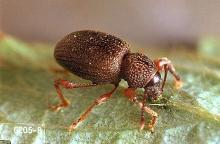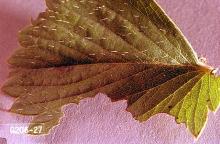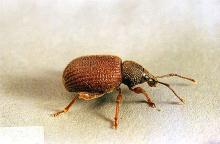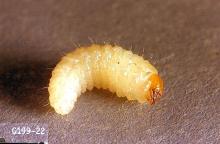Numerous species
Pest description and damage Adult weevils are between 0.2 to 0.25 inch long dark beetles with a snout (rostrum) and elbowed antennae. They cannot fly, so distribution is through migration or movement of infested plants, soil or debris. The adults of most of the species are all females and capable of laying eggs. They are slow moving and not confused with swifter predacious ground beetles. Frequently adults cause the most conspicuous damage. Adult weevils are night feeders that mostly remain in the soil or in debris at the base of the plant during the day, then climb up to feed on leaves at night. Look for ragged notches on the edges of leaves, or flower petals. Twigs of plants may die beyond where weevils have girdled the twig (salal, rockrose, yew, juniper, etc.). Larvae, found around roots, are C-shaped, legless, and white, or slightly reddish, with tan heads, up to 0.5 inch in size. All species are quite similar in appearance and habits of feeding on root hairs, larger roots and root crown. Check the base of unthrifty shrubs for symptoms of girdling by larvae.
Biology and life history Adult root weevils are present in every month of the year in mild climates. Most species have adults that are abundant from May through September. Larvae of these species overwinter in the soil around the roots. Adults of other species emerge in late summer and may be active through the winter and very early in spring in milder climates. The larvae of the fall emerging species are likely to be present during the summer months. There is only one generation per year.
Pest monitoring Observe leaves for fresh notching in early spring and continue throughout the season. Start with visual inspection of damaged plants by day, and then concentrate nocturnal flashlight searches, just after dusk, in those areas. At night, weevils can be dislodged onto a beating sheet, or pizza box, or captured in pitfall traps. Several newly developed traps for trapping adult root weevils are available as a monitoring tool. Inspect unthrifty plants for missing roots, root hairs or for small white, C-shaped grubs.
Management-cultural control
Root weevils are inconsistent in their damage to landscape plants: there appear to be sun/shade influences, host and cultivar preferences, based on physical and chemical characteristics of plant genera, species and cultivars. Different plant cultivars may be particularly susceptible or relatively resistant to root weevils. Cultivation of the soil in April and May can eliminate overwintering larvae before planting. Use a cereal cover crop to disrupt weevil numbers, as small grains are not a recorded host for root weevils. Hand-pick adults when found.
Management-biological control
At least two species of parasitic tachinid flies and one braconid wasp have been reared from some species of root weevils. Good control was obtained by placing shredded oak leaves under plants to encourage ground foraging birds. Beneficial nematodes have shown some effectiveness in controlling larvae when applied as a drench as the label directs. Place beneficial parasitic nematodes in the root zone where weevil larvae are; the soil must be moist and the soil temperature above 55°F. Nematodes are available at some garden and nursery stores and through mail order.
Management-chemical control
See Tables 2 and 5 in:





